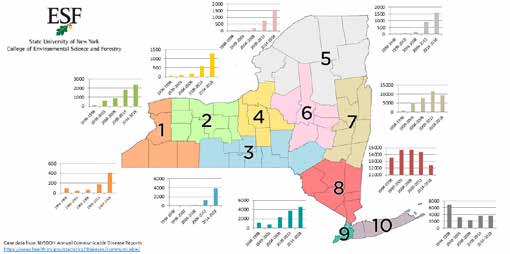BY KATHRYN RUSCITTO, ADVISOR

 Ticks can carry a variety of illnesses. The past few years, we are seeing new varieties of ticks with higher infection rates. The diseases they carry are often missed or mistaken for other illness and can quickly turn dangerous.
Ticks can carry a variety of illnesses. The past few years, we are seeing new varieties of ticks with higher infection rates. The diseases they carry are often missed or mistaken for other illness and can quickly turn dangerous.
According to Dr. Kristopher Paolino, MD, assistant professor of medicine and assistant professor of microbiology and immunology at SUNY Upstate Medical University – our local clinical expert in Tick Borne diseases – anaplasmosis is spreading in the deer tick population in our area.
“We’ve seen several dozen in the Syracuse region over the past two years,” Paolino said. “Patients generally present within a week of a tick bite, with high fevers, headaches and flulike illness. Labs show low platelets and WBC. Liver enzymes (AST and ALT) are moderately elevated. Many will have some vague GI upset. They can go downhill quickly if doxycycline isn’t started, and it can be lethal.
“Luckily, doxycycline usually results in improvement within one to two days after starting it. It’s the closest thing to a magic trick I can do. I think the big thing is to be aware of anaplasma and babesia in our area due to tick borne diseases.”
During 2011 through 2019, a total of 16,456 cases of babesiosis were reported to the Centers for Disease Control by 37 states; New York reported the largest number of cases – 4,738 total, an average of 526.4 per year.
Why is this increase happening? According to ESF Assistant Professor of Epidemiology & Disease Ecology Dr. Brian Leydet, MPH, our regional research expert on ticks, global climate change and other factors are making new habitats suitable for the blacklegged ticks survival resulting in increases in reported cases of human Lyme disease in areas we didn’t see much disease 15 20 years ago.
So what can we do about this increased risk? We recommend prevention education with patients and community groups.
• Be tick aware
• Avoid areas where ticks hide (wood piles, high grasses, leaves)
• Wear light-colored clothing when hiking
• Apply approved repellants
• Remove any ticks you find embedded and send for testing
• Examine yourself and other members of your household – and don’t forget the pets
• When returning from a hike, put clothing in the dryer for 15 minutes on high.
For more information, visit globallymealliance. org/about-lyme/prevention/
be-tick-aware/.
Locally, the CNY Lyme and Tick Borne Disease Alliance offers community education for groups, camps and clubs. For more information, contact Elizabeth Balfour at cnylymealliance.org/ or 315.551.2551. Ticks are here, and we need to protect ourselves and our families through prevention and quick action when a tick bite occurs. Be tick aware, and help educate your patients and teams.
Resources
1. cdc.gov/ticks/longhorned-tick/index.html
2. cdc.gov/mmwr/volumes/7 /wr/mm7211a1.htm?s_cid=mm7211a1_w
3. Central NY Lyme and Tick Borne Disease Alliance cnylymealliance.org/
4. Dr. Brian Leydet, Jr., MPH leydetlabesf.weebly.com
5. Dr. Kris Paolino, Infectious Disease upstate.edu/id/healthcare/ida/physicians-
staff-profile.php?empID=paolinok
Kathryn Ruscitto, Advisor, can be reached
at linkedin.com/in/kathrynruscitto or
at krusct@gmail.com





